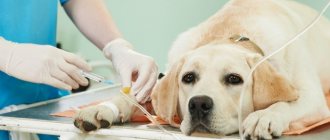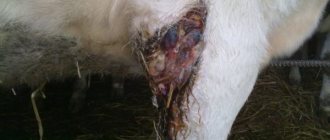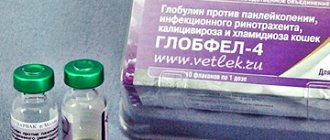Our dogs delight us not only with their devotion, but also with their activity, when they happily run around on a walk or show miracles of understanding during training. But both activity and training can become a factor when a dog’s paw breaks , which is a fairly serious condition for the animal and a great risk to its health. And this cannot be ignored!
In this article we will tell you what knowledge will help you provide first aid so that the treatment is effective and the prognosis is favorable.
A little anatomy or which parts of the paws are at risk
Dogs use 4 paws to move. The forelimbs consist of:
- shoulder and humerus;
- the forearm, in which the ulna and radius bones are united by a joint;
- wrists of 7 bones, connected to the heel bones;
- calcaneus (carpal) with 5 fingers.
The hind limbs have a slightly different structure and consist of:
- thigh with the femur, which is connected by a joint to the pelvic bone;
- knee;
- lower leg with tibia and fibula;
- hock joint;
- foot along with metatarsus and toes.
It is the hind limbs that are much stronger and stronger than the forelimbs. With their help, a push is performed for a jerk or jump.
Radioulnar fractures in puppies
The bones of the forelimb are the radius and ulna. This is a common fracture that usually occurs when a puppy jumps off furniture or someone's hands. Most often, both bones break right above the wrist. The vast majority of situations require a plate and screws to properly realign and heal this fracture. Splints on their own are usually a recipe for failure in small dogs because their blood vessels (which provide nutrients) are different from larger breeds.
Symptoms of paw fractures. What to pay attention to
Accident is the main factor when various bone fractures occur in dogs. Therefore, when walking with his animal, the owner must carefully monitor the dog’s behavior so as not to miss a fracture of any of the dog’s paws and the symptoms that appear. The behavior of an injured dog manifests itself in the following signs:
- an open fracture of a dog's paw - skin damage occurs at the fracture site, bleeding from the wound reveals the bone;
- closed fracture with displacement – damage to the bone anatomy;
- crack or linear closed fracture – swelling;
- the pet holds its front or hind leg in a suspended position;
- may limp or not step on the injured leg at all;
- the site of injury begins to swell and thicken;
- the natural state of the paw is absent: dangling or bent;
- when touching the limb, you can hear a strange friction in the area of the fracture. This is how bone fragments rub;
- if you touch a sore spot, the dog whines and tries to avoid touching.
Also, when a dog’s paw is broken, other symptoms may appear: general lethargy, it reacts little to what is happening nearby, refuses “sweets” and food, and the temperature rises. The symptoms of fractures of any bones in different dogs are quite eloquent, and an attentive owner will immediately pay attention to this. How to determine a fracture in a dog yourself? Watch the behavior of the animal!
IMPORTANT! The manifestation of even a single symptom is a reason to immediately contact a veterinary hospital. Do not try to self-medicate, and do not hope that everything will go away on its own.
Recovery period after a fracture
Regardless of whether your pet's injury is a broken heel, a neck injury, or a broken tail, he will need careful care during his illness and during the recovery period after it.
During illness, your pet needs rest, so you need to walk your dog as needed and for short periods of time. For small dogs, it is possible to walk in the arms of the owner, and if your pet is too big, you can carefully take it outside so that it can relieve its natural needs.
As the condition improves, the dog will become more active, but you should remain firm and limit the animal's jumping and running, as this can damage bone healing.
Due to the fact that the fracture limits the dog’s physical activity, it is better to review its diet and make it low-calorie so that your pet does not gain excess weight.
Keep an eye on your dogs on the street and at home so that they do not get into traumatic situations, pay attention to their behavior and mood, and promptly contact veterinarians at the first signs of deterioration in health, without waiting for the problem to resolve on its own.
To prevent such situations from happening in the first place, try to always keep your dog on a leash near busy highways or in places where other dogs gather. Car accidents and fights with other animals are the main causes that can lead to a fracture.
Close windows in a timely manner if you live on high floors, remove things that could fall and injure the animal. It is better to prevent a disease than to correct it!
Sources:
https://www.belanta.vet/vet-blog/perelom-sobaki/
https://www.minepets.ru/sobaki/bolezni/chto-delat-esli-sobaka-slomala-lapu.php
Do no harm or first aid for a dog with a broken hind or front paw
An injury occurred, all the symptoms are obvious. What to do if a dog's paw is broken? Provide first aid immediately! Actions must be quick and correct, but not to cause harm.
- Put on a muzzle or tie your mouth with something. This is necessary so that the dog does not bite in pain.
- With an open wound, you need to stop the flow of blood. To do this, apply a tourniquet, belt, belt, scarf, or something similar. There must be a piece of fabric under the tourniquet so as not to damage the skin.
- Clean the area where your dog’s hind or front paw is broken from dirt or dust. Suitable products include hydrogen peroxide, furatsilin solution, and other antiseptics. Iodine, alcohol, brilliant green should NOT be used. Shock from the pain may occur. After treatment, it is advisable to loosely bandage the fracture site of the dog’s front or hind paw to prevent possible contamination.
- Apply a splint (fix) using available items so that your shaggy friend does not move his paw.
After these steps, you need to go to the veterinary hospital and see a doctor. Transportation is carried out in a special container, and for large breeds, the dog must be supported under the sternum, helping it walk on three legs, and then carefully placed in the back seat of the car. The main condition is not to put stress on a damaged, broken bone.
How to transport an injured dog
Transporting your pet to the veterinarian can be a daunting task. If not done correctly, you could aggravate the injury or cause your animal additional pain. If your dog is small, carefully carry him into the car, supporting his head and hips. If the dog is a larger breed and can walk on its good legs, help it maintain its balance as it walks to the car, and then gently help it into the car. If your large dog is unable to walk, you and a helper can place him on a blanket and carry him in it, like in a sling. Once your dog is in the car, place him on his healthy side. When you get to the veterinary clinic, immediately tell the staff that you have an injured dog in the car and they will help you carry it inside.
Remember that an injured dog may become fearful or react aggressively to pain. This may cause her to behave differently than usual, such as snapping at you or whining when you touch the injured area. Know that this is not serious, she is just in a lot of pain. If she is particularly aggressive, you may need to ask for help to restrain her, or even temporarily muzzle her. Keep talking to her in a calm voice to reassure her that everything will be okay. Once she gets better, her behavior will most likely return to the same. Otherwise, if her aggressive behavior continues after recovery and rehabilitation, it is advisable to consult with your veterinarian to see if there are any other health problems that require treatment.
Veterinarian help
Treatment of any fracture in dogs begins with diagnosis. To do this, the veterinarian numbs the site of the injury, conducts an examination and prescribes an x-ray, which can be performed in different projections in order to see the picture more fully. In order not to miss other negative manifestations, an MRI or ultrasound may be prescribed. For uncomplicated fractures of a dog's paws, treatment is prescribed conservatively: applying a plaster cast. For complex closed or open fractures, surgery is prescribed, which is practically prescribed in 90 cases out of 100.
Osteosynthesis or bone fusion
The surgical process is to correctly put the broken bones and fragments into one whole. Practice has proven that broken bones will quickly heal without complications if the fragments have been folded and fixed correctly.
Several methods of operation are used.
- Application of the Ilizarov apparatus. Broken bones are securely fixed with knitting needles equipped with metal rings. Most often, this method is used for dogs of medium and large breeds. The ring is not removable and holds the rings tightly.
- Performing surgery for a broken paw in a dog using the Kishner apparatus, which structurally consists of special rods in the form of self-tapping screws. Such a device is in demand if the fracture is intra-articular without the possibility of installing an Ilizarov structure. Today this is a more modern design, which uses much thinner self-tapping rods, as well as plastic rods.
- Fixation from the inside. A very complex method of operation that excludes the use of devices. With internal fixation, special pins are screwed into the tubular bone inside. The pins remain in the bone for life. A very complex operation that requires a lot of experience and knowledge of a veterinary surgeon.
The method of operation is the decision of the veterinarian based on the medical history. It all depends on how complex the fracture is, in what place it is and whether additional actions will be needed (surgery on damaged internal organs, the condition of the dog, etc.).
Treatment for a broken paw in a dog
Your veterinarian will want to take x-rays of the injured paw to make sure it is broken and to determine the best treatment. Your dog may be given an NSAID, a non-steroidal anti-inflammatory drug, to help relieve pain. Don't try to do this yourself, as many over-the-counter human medications are not suitable for animals. When you make an appointment with your veterinarian, you can ask what you can do to relieve her pain before you arrive at the clinic. If your paw is truly broken, your doctor will discuss the best treatment option: simply set the leg and apply a cast or splint, or surgically repair the paw bones using wires or a plate. The best treatment option for a fracture depends on several factors, including the type and location of the fracture and the age of the dog, which affects bone strength.
Treatment and further care
If there is a suspicion of a broken finger, the dog needs to be kept at rest . Transport to veterinarian by hand or vehicle to minimize dislodgment of fragments. Finger fractures require mandatory x-ray diagnostics to determine the nature of the fracture and its complexity. Based on the diagnostic results, the specialist will decide how exactly the animal should be treated in the future. If only one toe is fractured, treatment may involve applying a fixative plaster cast to the lower part of the paw. Complex, comminuted fractures may require surgery to install a plate or pin.
After treatment by a specialist, further care of the animal falls on the owners. Depending on what method was used to treat the fracture, subsequent care also differs.
If the fracture was not too complex and the treatment was reduced to the application of a fixing or plaster bandage, then the actions of the owners will consist of caring for the skin where the plaster bandage ends. Since a bedsore may form there, it is necessary to treat the skin with antiseptic preparations and do a light massage. Another problem with plaster casts is dogs chewing them off. Animals often try to remove an object that is bothering them.
The simplest remedy for such actions is a closed muzzle . But it is inconvenient to wear constantly, especially considering the fact that the plaster cast is applied for up to a month and a half. A good solution in this case is to use special bandages treated with hot pepper extract. You can also use the so-called “Elizabethan” collar.
If the method of fixing the fragments with a plate or intraosseous pin was chosen to treat the fracture, caring for the animal will be easier. With this solution, the animal can almost immediately put weight on the injured limb and lead a normal way of life. Owners are required to provide only minor care to the sutures at the surgical site. Usually the sutures are removed on days 7-10. And in the future there is no need for any specific observation.
Regardless of the treatment method, after 1.5-2 months, X-ray monitoring of fracture healing is carried out. And both the plaster cast and the plate or pin are removed.
General information about fractures
Fractures occur quite often in veterinary practice and can occur in various parts of the body. Most often the forelimbs, hind limbs, as well as the spine and pelvic bones are affected. In veterinary surgery, all fractures are divided into two types:
- open fracture - characterized by a violation of the integrity of not only the bone, but also the skin (a piece of bone may stick out through the mucous membranes or skin);
- closed fracture - it is characterized by the absence of visible violations of the integrity of the structures of the skin and mucous membrane.
In addition, in surgery, simple fractures are divided, when the bone is broken into two parts, and complex, as a result of which the bone is crushed into fragments.
How is the postoperative period going?
Typically, a dog or cat after such an operation spends 6 to 24 hours in the clinic under observation. After this, suture treatment and painkillers are usually prescribed for 3-5 days. It is recommended to limit mobility for 4-6 weeks in order for the rehabilitation of the dog’s paw after a fracture to be successful (cats and small dogs can be placed in a large cage; large dogs are walked strictly on a leash). Typically, weight bearing is restored 3-5 days after surgery.
After 3-4 weeks, you will be asked to bring your dog or cat in for a follow-up x-ray to assess the rate of fusion. On average, the healing time, depending on the complexity of the fracture, ranges from 2 to 8 months. After fusion, with the exception of rare cases (intra-articular fractures, fractures of the pelvic bones, very complex fractures in which the fixing elements firmly grow into the general mass of callus), the metal structures are removed.











